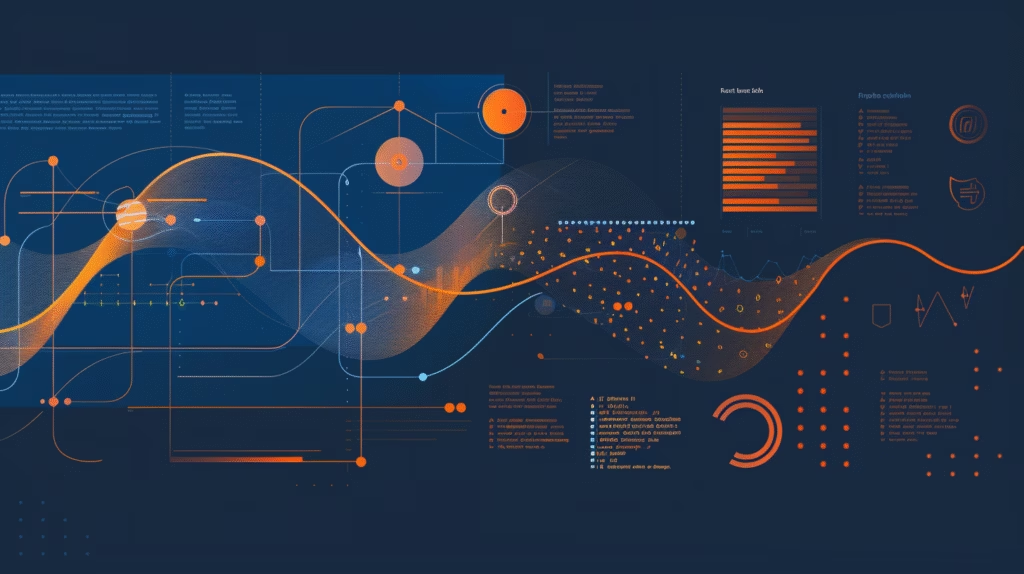Every call center conversation can shape your business, but raw voice data often sits untapped. Manual call reviews rarely keep up with the volume or complexity of today’s customer service needs.
Speech analytics brings clarity by turning spoken words into actionable insights using AI, speech-to-text, and natural language processing. Speech analytics relies on speech recognition and automatic speech recognition technologies to convert spoken language into text for analysis.
With the right approach, you can reveal trends, measure sentiment, and address compliance issues across every conversation. Conversation analytics takes this further by analyzing customer interactions across multiple channels to improve customer experience. Leaders who depend on reliable call center analytics now have a way to unlock the full potential of their voice data.
What Is Speech Analytics?
Speech analytics is a technology that turns spoken conversations into actionable business insights. At its core, speech analytics uses AI, speech-to-text transcription, and natural language processing to analyze recorded voice calls and live interactions, making it possible to extract data that improves customer satisfaction, compliance, and team performance.
Beyond Basic Call Recording
Traditional call recording simply stores audio for later playback. Speech analytics goes further by converting audio to text, then scanning for keywords, phrases, and customer sentiment. This approach highlights themes, uncovers compliance risks, and tracks how agents follow scripts or handle objections.
Modern speech analytics identifies not just what was said, but also how it was said. It pinpoints emotions, detects stressful moments, and recognizes silences or interruptions. These tools analyze human speech to interpret emotions, stress, and intent during customer interactions. This level of detail gives organizations a much clearer picture of customer needs and agent behaviors.
Evolution and Business Value
This technology helps businesses in regulated industries meet documentation needs, manage risk, and deliver better service. Speech analytics supports foundational goals in customer experience, compliance, and performance management by transforming raw audio into data that leaders can use to make informed decisions, coach teams, and protect their organizations.
Companies using Voice of Customer analytics report churn rates 5-7 times lower than organizations not using these technologies and achieve customer lifetime value improvements of 25%.
Speech analytics has evolved from slow, manual quality assurance to real-time, automated analysis. In the past, supervisors could review only a handful of calls each week. Now, AI-driven tools review thousands of conversations, surfacing patterns and opportunities for improvement.
This technology supports foundational goals in customer experience, compliance, and performance management by transforming raw audio into data that leaders can use to make informed decisions, coach teams, and protect their organizations.

How Speech Analytics Works: From Audio to Business Intelligence
Speech analytics transforms the way organizations handle call center analytics by converting raw voice data into clear business intelligence. A speech analytics platform is the system that consolidates and analyzes data from multiple customer calls to uncover insights, detect trends, and inform actions for enhancing both employee and customer experiences. Understanding how this process works helps you see the real value behind every conversation.
The Technology Stack Behind Speech Analytics
Modern speech analytics relies on several key technologies working together. Artificial intelligence powers the platform, while speech-to-text transcription captures every word spoken during customer interactions.
Natural language processing (NLP) then examines those transcripts, identifying keywords and phrases, and detecting sentiment or emotional tone. These tools allow you to track trends, compliance, and customer satisfaction without manual review.
Step-by-Step: From Call Capture to Insight
Seamless integration is essential for maximizing the impact of speech analytics. Leading solutions connect multiple communication platforms, bringing together voice, chat, video, and SMS on a single dashboard. This central hub allows you to manage all customer interactions in one place, reducing complexity and improving workflow.
Integration with call center analytics software ensures you access reports, track KPIs, and respond to trends without switching tools. Organizations implementing speech analytics report customer satisfaction improvements of 10% or more and cost savings of between 20 and 30%.
When your systems work together, you make better use of your call recordings by turning them into actionable insights, driving better results for your business.
Real-Time Versus Post-Call Analysis
Speech analytics platforms offer both real-time and post-call analysis. Real-time analytics monitors calls as they happen, alerting supervisors to compliance risks or customer distress. Monitoring call quality in real time helps assess agent effectiveness and customer satisfaction. Teams can intervene or coach agents while the conversation unfolds, improving outcomes on the spot.
Post-call analysis takes a deeper look after the call ends, reviewing transcripts for recurring issues, tracking customer sentiment over time, and uncovering patterns that guide long-term strategy. Analyzing call openings in post-call analysis can identify areas for training and process improvements. Both modes play a vital role in delivering fast feedback and supporting continuous improvement.

Key Benefits of Speech Analytics for Business
Speech analytics brings measurable improvements to customer service, team performance, and operational efficiency. By capturing insights from every call, organizations uncover trends and address issues sooner, building a better experience for both customers and employees.
Improving Customer Service and Satisfaction
Speech analytics reveals the real reasons behind customer frustration or delight. Businesses can identify pain points, track common questions, and discover opportunities to exceed expectations.
For regulated industries, understanding every detail of a customer’s interactions supports compliance and builds trust with patients, clients, or account holders. Instead of relying on guesswork, teams use real data from call center analytics to refine scripts, adjust processes, and deliver more consistent support.
Optimizing Agent Performance and Training
With automated feedback and targeted insights, supervisors provide agents with timely coaching based on actual interactions. Speech analytics highlights missed greetings, unclear explanations, or compliance gaps, allowing for quick correction and growth. In addition, speech analytics supports contact center performance by delivering automated scoring and performance metrics, helping to monitor and enhance both agent quality and operational efficiency.
This approach promotes skill development and helps agents feel supported, not just monitored. Continuous improvement becomes part of the workflow, leading to higher first-call resolution and reduced turnover.
Increasing Operational Efficiency and Reducing Costs
Manual call reviews require significant time and resources, but speech analytics automates quality assurance across all conversations. This reduces the need for random sampling and speeds up issue resolution. By leveraging data analysis to identify and address process inefficiencies, speech analytics helps improve operational efficiency by streamlining processes and reducing handling times.
Organizations see lower training costs, faster onboarding, and fewer escalations. With more efficient processes, teams can focus on higher-value tasks instead of repetitive manual checks.
Enabling Data-Driven Decision-Making
Leaders rely on speech analytics to track trends, measure the impact of new initiatives, and monitor compliance in real time. Dashboards and reports make it easy to spot shifts in customer sentiment or emerging issues.
With this data, organizations make proactive changes, analyze agent performance, allocate resources wisely, and ensure that every decision is backed by evidence. The result is a more agile, responsive business that meets both regulatory and customer demands.
Main Use Cases and Applications Across Industries
Speech analytics finds practical value in a wide variety of business environments. Each industry and team faces its challenges, and speech analytics helps address them by turning conversations into actionable insights.
Elevating Customer Support in Contact Centers
Contact center analytics powered by speech analytics captures patterns in customer calls and helps teams understand why customers reach out.
Supervisors can pinpoint recurring issues, identify top-performing contact center agents, and uncover training gaps. This leads to faster resolution times, fewer escalations, and stronger customer satisfaction.
Sentiment Analysis and Brand Management
Sentiment analysis provides a window into each customer’s experience. By monitoring tone, word choice, and emotional cues, businesses can spot unhappy clients before problems escalate.
Positive trends show what works, while negative feedback highlights areas for improvement. Tracking sentiment at scale helps secure brand reputation and build loyalty.
Real-Time Quality Assurance and Compliance
Real-time speech analytics supports the training of contact center agents and compliance efforts. When a call includes risky language or misses required disclosures, supervisors receive alerts and can intervene right away.
This proactive approach reduces regulatory risk in fields like healthcare and finance while keeping coaching timely and relevant.
Process Improvements Through Data-Driven Insights
Speech analytics does more than monitor performance. It reveals the root causes of repeated issues, such as confusing billing terms or technical glitches that drive up call volume.
Armed with this data, leaders can update scripts, refine workflows, and prevent future problems, leading to overall operational efficiency.
Industry-Specific Applications
- Healthcare: Supports patient engagement by tracking appointment calls, follow-up instructions, and HIPAA compliance.
- Finance: Detects potential fraud by flagging unusual questions, missed disclosures, or suspicious behavior.
- Legal Services: Enables call audits, ensuring conversations align with legal best practices and client confidentiality.
Speech analytics adapts to the needs of each sector, providing clarity and transparency in every customer interaction.
Whether you want to improve service quality, reduce compliance risk, or uncover new growth opportunities, speech analytics offers the tools you need to move forward with confidence.

Speech Analytics vs. Other Analytics Tools
Selecting the right analytics tools starts with understanding how speech analytics compares to other options in the call center analytics landscape. Each solution provides unique value, but the impact grows when you combine their strengths.
Comparing Analytics Approaches
- Speech analytics focuses on turning voice conversations into actionable insights. It captures both what callers say and how they say it, revealing customer sentiment, compliance risks, and recurring issues across all customer calls.
- Text analytics examines written interactions such as chat, email, or SMS. While it finds trends in digital channels, it cannot identify tone or emotion like speech analytics.
- Voice analytics measures the acoustic qualities of a call, including pitch, silence, and stress. It excels at detecting emotion but does not analyze words or intent.
- Conversation intelligence combines speech and text analytics with advanced AI to track engagement across every channel and create a unified customer journey.
When and How to Use Each Tool
Use speech analytics when voice calls drive your business, compliance matters, or you need to improve agent performance. Text analytics works best for written support, while voice analytics highlights emotional cues. Conversation intelligence supports a complete omnichannel strategy.
For the strongest results, integrate speech analytics with your broader analytics software. Speech analytics tools analyze customer conversations in real time to understand customer sentiment, improve customer service performance, and reduce costs. A multi-modal approach gives you a clear, data-driven view of every customer interaction and maximizes your business impact.
Powering Business Growth with Speech Analytics Solutions
Unlocking the full value of speech analytics starts with the right platform and support. AI-powered speech analytics within modern unified communication platforms provides businesses with an integrated approach to voice data, sentiment analysis, and real-time insights.
With features like automated transcription, keyword recognition, and emotion detection, teams gain instant access to trends that drive better customer experiences and faster resolutions.
The Role of Dedicated Support and Technical Expertise
Successful speech analytics adoption depends on more than advanced technology. Dedicated support teams and technical specialists guide you through setup, integration, and ongoing optimization.
Personalized onboarding and expert troubleshooting help you avoid common pitfalls and adapt solutions to your specific workflows. A reliable support network ensures your team receives timely assistance and maximizes return on investment.
Scalability, Customization, and Key Considerations
Every organization requires scalability to handle growth and changing communication volumes. Look for solutions that adjust to your needs, whether you manage a small team or a multi-site enterprise.
Customizable analytics dashboards and industry-specific features support compliance in sectors like healthcare, finance, and legal services. Security and data privacy must remain top priorities, with private cloud hosting and robust access controls providing peace of mind.
When selecting a speech analytics solution, consider:
- Ease of integration with existing UCaaS software
- Compliance with industry regulations and data protection standards
- Flexibility to configure reports, alerts, and workflows for your business
A specialized speech analytics solution serves as a catalyst for operational transformation. With actionable insights and a platform designed for your industry, you can improve team performance, reduce risk, and deliver the customer satisfaction that drives business growth.

Take the Next Step: Transform Customer Conversations into Strategic Value
With speech analytics, you don’t just get data—you get the context behind it. It helps you elevate customer experience, increase agent performance, and maintain compliance, all while putting real insights at your fingertips.
By using data from every conversation, you can spot trends, resolve issues faster, and make informed decisions that move your business forward.
Techmode’s unified communication platform brings together AI-powered speech analytics, secure cloud hosting, and dedicated U.S.-based support. Our team stands ready to help you customize your solution, integrate with your current systems, and scale as your needs change.
Now is the time to stop relying on assumptions—get insights based on real conversations and unlock the full value of your customer conversations. Connect with Techmode for a personalized consultation.
See how you can use speech analytics to drive operational excellence, build trusted relationships, reduce churn, increase repeat business, and make data-backed improvements that scale with you.
Frequently Asked Questions
What is speech analytics, and how is it used in business communication?
Speech analytics uses AI, speech-to-text technology, and natural language understanding to turn voice calls into structured data. Businesses use insights from these conversations to improve customer service, strengthen customer relationships, monitor compliance for better risk management, and guide strategies that lead to measurable business outcomes.
How does speech analytics work to analyze call center conversations?
The system records calls, transcribes the audio, and applies analysis software powered by natural language understanding. It detects keywords, identifies customer pain points, measures sentiment, and spots compliance risks. This process enables more effective quality management and trend analysis of customer behavior, helping managers quickly address issues, coach agents, and track performance.
What are the main use cases and benefits of speech analytics for organizations?
Key use cases include enhancing call center analytics, supporting agent training, improving quality management, and automating quality assurance processes. Speech analytics drives sales optimization by identifying buying signals, helps resolve issues faster, reduces manual reviews, and enables data-driven decisions that can increase customer satisfaction.
Can you share real-world examples of speech analytics in action?
Healthcare providers use speech analytics to monitor patient calls for regulatory compliance and risk management. Financial institutions track calls for fraud indicators, while legal teams use insights to improve service, documentation, and client trust. Retailers apply speech analytics to uncover customer pain points and adjust operations, leading to improved business outcomes.
How does speech analytics differ from other analytics tools like text analytics or conversation intelligence?
Speech analytics focuses on spoken conversations, converting them into actionable insights through trend analysis and evaluation of customer behavior. Text analytics reviews written communication channels, while conversation intelligence unifies data across voice, text, and video. Each tool offers unique advantages, but together they can help organizations refine strategies, strengthen customer relationships, and increase customer satisfaction.









